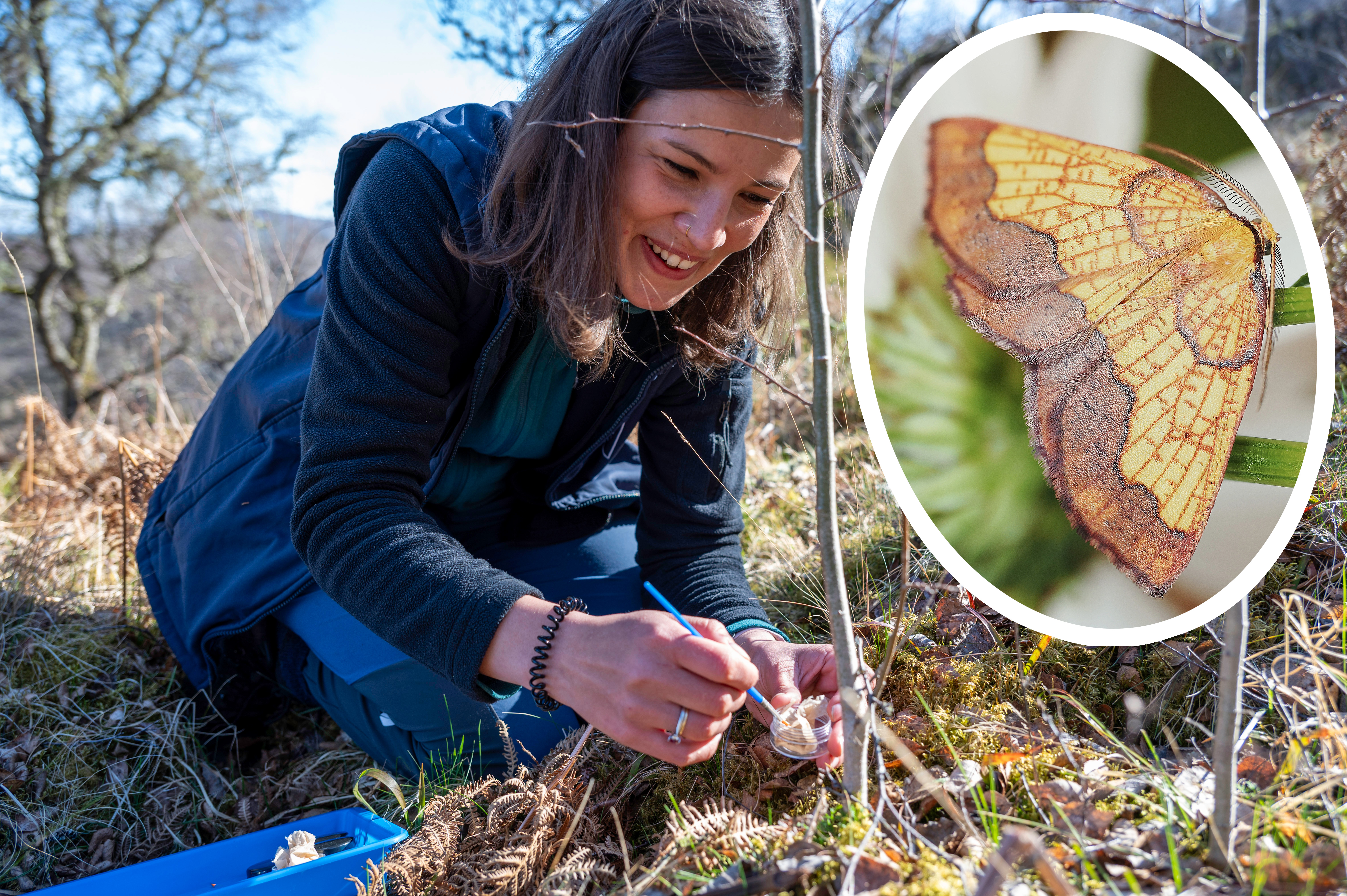Moth experts in Scotland kick off unique four-month ‘Easter egg hunt’
Posted 17 Apr 2025 in Highland Wildlife Park

Conservationists in Scotland have kicked off a unique four-month ‘Easter egg hunt’ involving one of the UK’s rarest and most beautiful moths.
A team led by the Royal Zoological Society of Scotland (RZSS) have released 400 eggs of the dark bordered beauty moth at a specially selected site in the Cairngorms National Park as part of a conservation programme. They will return to look for the adults in July.
The dark bordered beauty moth (Epione vespertaria) is an attractive moth. Females have lemon-yellow wings and prominent dark borders while males are darker and with ochre stripes. Sadly, due to years of habitat loss, it is now endangered in the UK and found at only two sites in Scotland and one in England.
The latest egg release on Friday, April 4, was part of the Rare Invertebrates in the Cairngorms (RIC) partnership project involving RZSS, Butterfly Conservation, RSPB Scotland, Cairngorms Connect and others.
Dr Helen Taylor, conservation programme manager at RZSS, said, “We are delighted to have a new release site for this incredible species where we can test whether releasing eggs is an effective strategy for reintroducing dark bordered beauty moths.
“We’ve been running a conservation breeding programme for this species since 2022 and have previously released caterpillars and adults with some success, but raising individuals to these stages of development is an intensive process. If we can show success with egg releases, we will be able to ramp up our efforts and do even more to help this rare and important species.
“Reversing species decline is critical in the current global biodiversity crisis. Invertebrates like the dark bordered beauty moth play vital roles in ecosystems, yet they are often overlooked. Thanks to our dedicated partners, funders and conservation supporters, we are making real progress in restoring this rare species.”
The RIC team took the eggs from a RZSS conservation facility where they are breeding dark bordered beauty moth to release into the wild.
The egg release took place on the WildLand estate, which is part of the Cairngorms Connect landscape, in an open clearing rich with aspen suckers and thick, damp mossy ground cover.
The eggs were placed at the base of the suckers where they met the moss, replicating the suspected natural egg-laying behaviour based on observations of the female moths in the RZSS facility.
The hope is that that caterpillars will hatch from the eggs, grow to full size and then pupate to undergo metamorphosis. The RIC team will return to the site when the moths normally emerge in July and use light traps to try to find adults to discover if the egg release has worked.
By tracking the success of this release, the team hopes to refine reintroduction strategies, ultimately increasing the moth’s numbers and reconnecting fragmented populations.
Butterfly Conservation’s Tom Prescott, head of conservation for Scotland, said: “Sadly, numbers of butterflies and moths across the UK have plummeted over the last century and one of the main causes is habitat loss. Thankfully, our work on dark bordered beauty moth over many years has shown us that, in Scotland, the caterpillars are associated with short Aspen suckers so we know how we can help this species.
“Projects like this demonstrate that by working in partnership and enhancing and providing the right habitats we can rebuild sustainable populations and help species recover in the long-term.”
Collaboration has been crucial to the project’s success so far. RZSS works closely with Butterfly Conservation, RSPB Scotland and other partners on the RIC project to maximise the potential for the moths’ survival.
The release site was chosen for its ideal conditions, as the area is rich in aspen suckers, diverse yet protected, with minimal footfall and free from extensive browsing that can severely impact the moth’s habitat. It is managed by WildLand, a group dedicated to restoring Scotland’s wilderness.
Ronan Dugan, field ecologist for WildLands, said: “The release of 400 eggs at WildLand Cairngorms marks a pivotal and poignant moment in the restoration process of this site. Since taking custodianship of the site in 2018, WildLand have embarked on sympathetically restoration the land, much of which is included in Alvie Site of Special Scientific Interest, to benefit many species. With the abundant regeneration and suckering of aspen it felt very timely to release the dark bordered beauty moth eggs. We are grateful for the expertise provided by RZSS and others while working in partnership on this project.”
This release represents a hopeful step forward in securing the future of the dark bordered beauty moth in Scotland. If successful, it will pave the way for further reintroductions and conservation efforts in the years to come.
This work is possible thanks to the Cairngorms National Park Authority, Cheeky Panda, players of People’s Postcode Lottery and the Scottish Government’s Nature Restoration Fund, managed by NatureScot.
The dark bordered beauty moth conservation breeding for release project runs in collaboration with RIC, a partnership between Butterfly Conservation Scotland, RSPB Scotland, Cairngorms National Park Authority, RZSS, Buglife Scotland and NatureScot.

